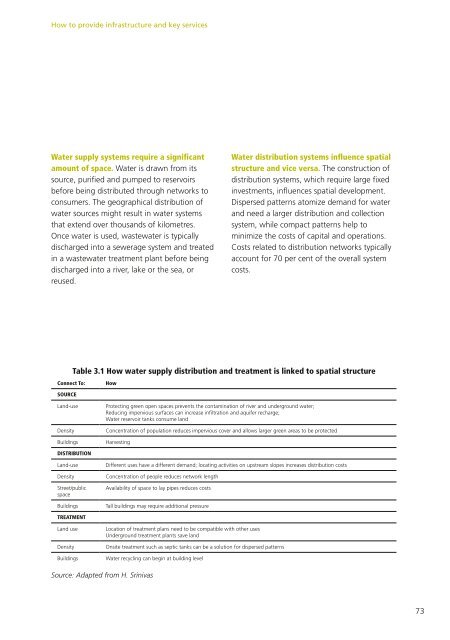Urban Planning for City Leaders - Cities Alliance
Urban Planning for City Leaders - Cities Alliance
Urban Planning for City Leaders - Cities Alliance
You also want an ePaper? Increase the reach of your titles
YUMPU automatically turns print PDFs into web optimized ePapers that Google loves.
How to provide infrastructure and key servicesWater supply systems require a significantamount of space. Water is drawn from itssource, purified and pumped to reservoirsbe<strong>for</strong>e being distributed through networks toconsumers. The geographical distribution ofwater sources might result in water systemsthat extend over thousands of kilometres.Once water is used, wastewater is typicallydischarged into a sewerage system and treatedin a wastewater treatment plant be<strong>for</strong>e beingdischarged into a river, lake or the sea, orreused.Water distribution systems influence spatialstructure and vice versa. The construction ofdistribution systems, which require large fixedinvestments, influences spatial development.Dispersed patterns atomize demand <strong>for</strong> waterand need a larger distribution and collectionsystem, while compact patterns help tominimize the costs of capital and operations.Costs related to distribution networks typicallyaccount <strong>for</strong> 70 per cent of the overall systemcosts.Table 3.1 How water supply distribution and treatment is linked to spatial structureConnect To: HowSOURCELand-useDensityBuildingsProtecting green open spaces prevents the contamination of river and underground water;Reducing impervious surfaces can increase infiltration and aquifer recharge;Water reservoir tanks consume landConcentration of population reduces impervious cover and allows larger green areas to be protectedHarvestingDISTRIBUTIONLand-useDensityStreet/publicspaceBuildingsDifferent uses have a different demand; locating activities on upstream slopes increases distribution costsConcentration of people reduces network lengthAvailability of space to lay pipes reduces costsTall buildings may require additional pressureTREATMENTLand useDensityBuildingsLocation of treatment plans need to be compatible with other usesUnderground treatment plants save landOnsite treatment such as septic tanks can be a solution <strong>for</strong> dispersed patternsWater recycling can begin at building levelSource: Adapted from H. Srinivas73
















